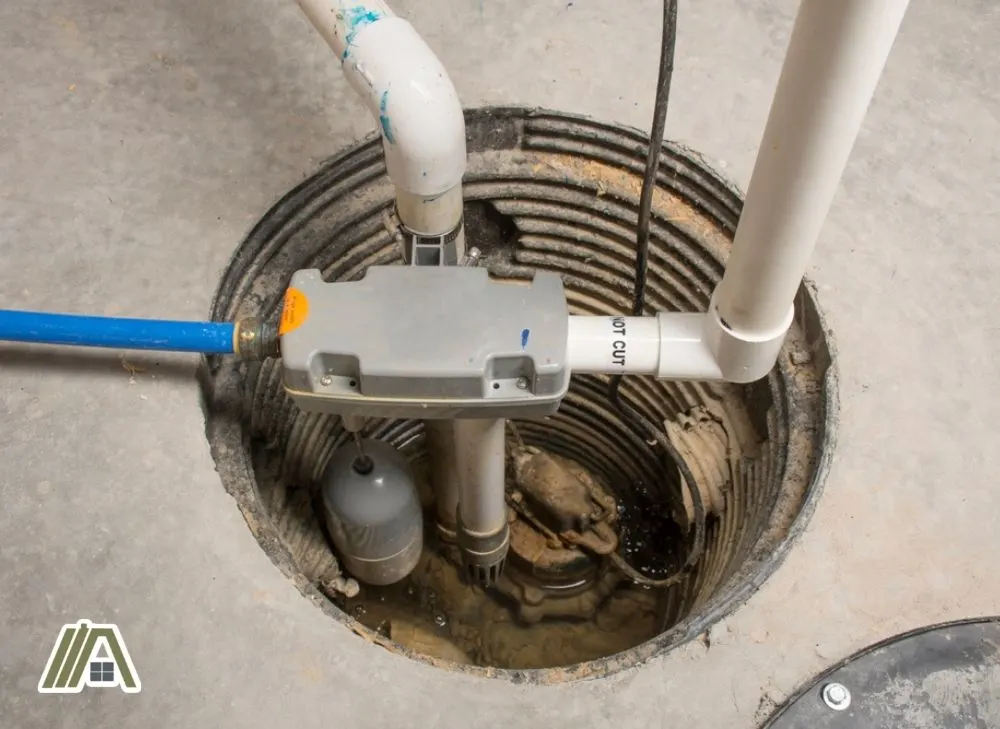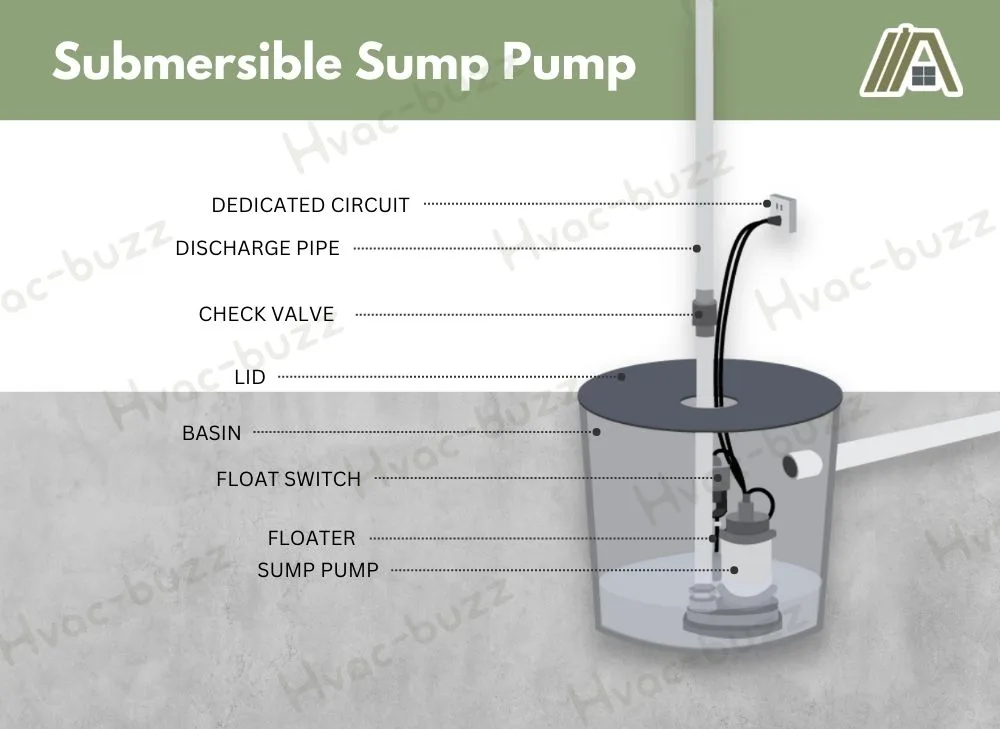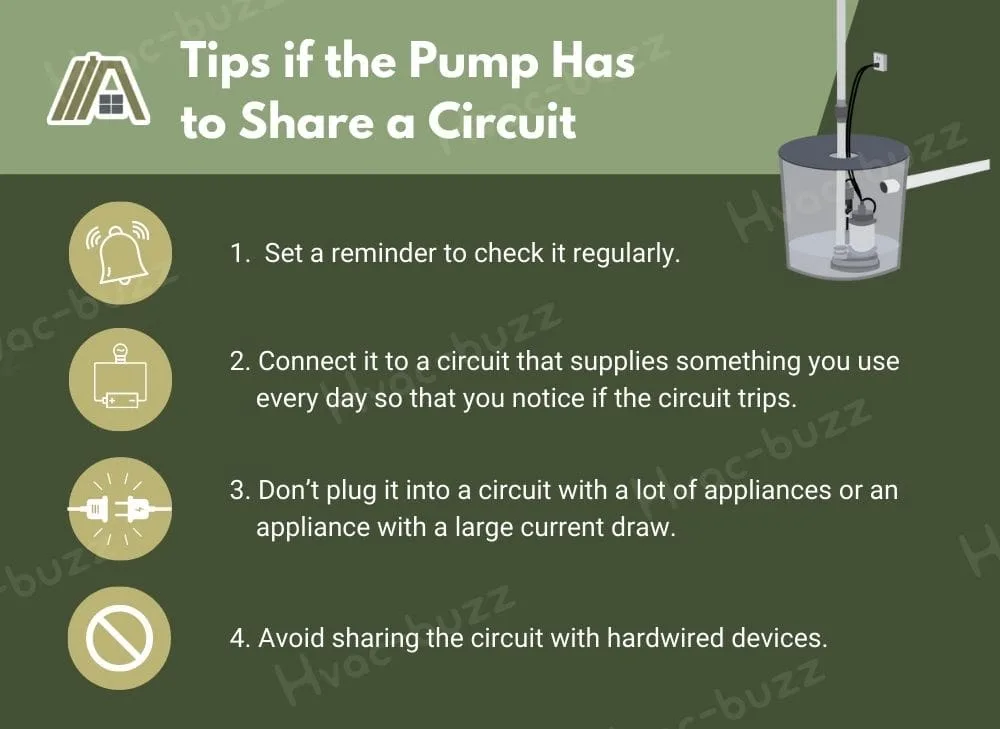If your basement has ever flooded, you may be installing or maintaining a sump pump. Sump pumps move water away from the basement into a safe drainage area. Understanding the electrical requirements and recommendations for sump pumps will help prevent flooding and ensure safety.
This article will help you ensure that your sump pump setup works and abides by recent changes to the NEC. If you cannot have a dedicated circuit, use the tips provided to avoid tripping the circuit and flooding your basement.

The IRC and NEC do not require dedicated circuits for sump pumps. However, some local codes and most manufacturers recommend connecting a sump pump to its own separate circuit. Whether or not there is a dedicated circuit, it must be protected by a Ground Fault Circuit Interrupter (GFCI).
Codes Don’t Specify Dedicated Circuits
The International Residential Code (IRC) is the main building code that regulates what and how you can add to your home. It applies to all states except for Wisconsin. The National Electric Code (NEC) applies to all fifty US states.
The IRC and NEC do not say that sump pumps must have their own circuit. They also do not say that sump pumps should share circuits.

In theory, a sump pump is allowed to share a circuit and circuit breaker with other devices. However, dedicated circuits are recommended for practical and safety reasons, which we will discuss shortly.
Although the primary building codes in the US do not specify dedicated circuits for sump pumps, some states may have additional rules, so check your local requirements.
Additionally, in Canada, Rule 26-700(8) of the Manitoba Electrical Code requires designated circuits for sump pumps.
If there are no relevant government guidelines where you live, refer to your sump pump manual for the manufacturer’s recommendations.
Dedicated Circuit Is Recommended Practice
Most professionals will recommend that you put the sump pump on a dedicated circuit. Major sump pump manufacturers like Wayne and Superior strongly recommend dedicated circuits.
A dedicated circuit means that the circuit supplies electricity to only one appliance, either directly (hardwired appliances) or through an outlet with only one appliance plugged into it.

You can test whether you’re working with a dedicated circuit by flipping individual breakers because dedicated circuits also have their own breakers (or fuses, if you live in an older house).
Ideally, you should plug your sump pump directly into its own circuit; you should not use an extension cord. In addition, most manufacturers recommend that the outlet should be 4 feet above the basement floor to prevent it from getting wet.
Reasons for Recommendation
Having a dedicated circuit helps avoid tripping the circuit. There are several reasons why an overloaded circuit is particularly risky when dealing with sump pumps.
High start-up current
Sump pumps typically use little energy day-to-day but need a lot of energy when it rains.
If you plug an additional appliance into a circuit alongside a sump pump, things might seem to be working well in dry conditions.
However, when the sump fills with water and the pump kicks in, there is a high start-up current.
If this initial power draw is greater than what the circuit can supply, it will trip. This will cause your sump pump to stop working when you need it most, leading to basement flooding.
Additionally, because your sump pump does not get used every day, you might not notice a tripped circuit until you’re in the middle of a rain event and the pump isn’t working.
Sump pumps are protection appliances
It is recommended that “protection appliances” like sump pumps and home security systems get their own circuits even if their power draw is not huge.
If the device is necessary for protecting your safety or preventing damage to your home, you want to be sure that it has power when it needs to.
Overloaded circuits are fire hazards
Wires can get hot and spark right before a circuit trips. Breakers are designed to cut off the power supply before a fire can occur.
However, circuit breakers can fail, especially if they are older. So, it is important not to overload the circuit in the first place.

If local codes allow it, you can plug your sump pump into a shared circuit if you need to. This can still be safe and effective if you:
- Set a reminder to check it regularly. Check that your sump pump is turned on and receiving power. Consider staying home during big rain events so that you can monitor the situation and turn the circuit back on if it trips.
- Connect it to a circuit that supplies something you use every day so that you notice if the circuit trips.
- Don’t plug it into a circuit with a lot of appliances or an appliance with a large current draw. Calculate the maximum draw of all appliances and limit the number and size of devices that share the circuit.
- Many common basement appliances like refrigerators, dryers and washing machines tend to require their own circuits anyways.
- Avoid sharing the circuit with hardwired devices. If you end up with a problem, you need to be able to remove all the other appliances from the circuit in order to allow your sump pump to function. If other appliances are hardwired into the circuit, this is not possible.
In addition, it’s really important that you consider getting a backup sump pump. Even if you have a dedicated circuit or are diligent about avoiding circuit trips, rain storms can cause power outages which leave your electrical sump pump useless.
Battery- or water-operated sump pumps will work even if your electrical circuit trips.
A battery backup sump pump can be bought at a hardware store and installed by the homeowner. It can run for up to 5-8 hours.
A water-operated sump pump runs for an unlimited amount of time. However, it must be professionally installed, your home must be supplied by municipal water lines, and installation can be difficult if your basement is finished.
GFCI Protection for the Circuit
The 2020 edition of the US National Electric Code (422.5 A) added sump pumps to the list of appliances that require GFCI protection. The NEC lists basements as locations that require GFCI protection, and most sump pumps are in basements.
The NEC used to say that sump pumps were exempt from GFCI protection if they were on a dedicated circuit. They are no longer exempt. Finished basements also used to be exempt, but as of the 2020 NEC, all basement circuits require GFCI protection.
A Ground Fault Circuit Interrupter (GFCI) prevents electrocution and blown fuses, particularly in environments where moisture is present. A GFCI outlet detects losses in the current and trips the circuit if any current starts flowing through a ground conductor.
Connecting your sump pump to a GFCI-protected circuit will ensure that you don’t end up standing in electrified flood water in your basement.
While GFCI outlets make us all safer, there are complaints about their practicality.
Sump pumps have a high start-up current, which the GFCI sometimes reads as a sudden change in the electrical current. This can cause a “nuisance trip” (a false alarm that shuts off the sump pump).
GFCI outlets can cause your pump to fail and your basement to flood, but you’ll be safe touching the floodwater. In the past, homeowners used to weigh the pros and cons of GFCI protection for sump pumps. However, the NEC now requires it.
To prevent issues, you can buy an audible alert GFCI that sounds an alarm when it trips.
How Many Amps Does a Sump Pump Draw?
Domestic sump pumps have 3 common sizes.
- ¾ hp (horsepower) sump pumps are powerful models for houses in areas with a high water table.
- ½ hp sump pumps are the most popular model.
- ¼ hp sump pumps are suitable for homes in areas where flooding is less of a concern.
The size of the pump determines its amp draw, which determines the amperage of the circuit that you can connect it to. Amp draw varies by model.
Use the chart below to estimate how much amperage you need.
When starting up, sump pumps will momentarily have a larger amp draw than listed. Make sure that your circuit has enough amperage to accommodate this start-up amp draw, not just the average amp draw.
| Size | Amp draw | Maximum amp draw (start-up) |
| Large (¾ hp) | 10-13.8 A | 15-20 A |
| Medium (½ hp) | 5-9.8 A | 10-15 A |
| Small (¼ hp) | 3.8 A | 5 A |

